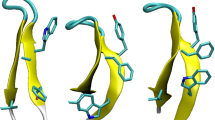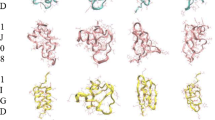Abstract
In the last decade many advances have been made on molecular dynamics simulations and different force fields were developed from the combination of differentiable functions of the atomic coordinates to represent the system energy and of parameters that describe the geometric and energetic properties of inter-particle interactions. However, it has been shown that very subtle modifications to commonly used molecular mechanical potentials can significantly alter the behavior of those potentials inducing stabilizing or destabilizing effects in the patterns of peptides or proteins. In this article we describe the behavior of polyalanine peptides under the influence of various “force fields”. The polyalanines were chosen as study model since their structural features were already studied experimentally and thus our computational results were easily comparable with the experimental ones. In particular, three peptides composed of 8, 10 and 12 alanine residues were subjected to molecular dynamics simulations using 12 different force fields to understand what is the most appropriate force field to properly simulate their folding. Our results showed that Amber99ϕ is the best force field able to generate helical conformations in agreement with experimental data.



Similar content being viewed by others
References
Box VG (1997) The molecular mechanics of quantized valence bonds. J Mol Model 3:124–141
Brown LY, Brown SA (2004) Alanine tracts: the expanding story of human illness and trinucleotide repeats. Trends Genet 20:51–58
Cornell WD, Cieplak P, Bayly CI et al (1995) A second generation force field for the simulation of proteins, nucleic acids, and organic molecules. J Am Chem Soc 117:5179–5197
Fu C–F, Tian SX (2011) A comparative study for molecular dynamics simulations of liquid benzene. J Chem Theory Comput 7:2240–2252
Garcia AE (2004) Characterization of non-alpha helical conformations in Ala peptides. Polymer 45:669–676
Guvench O, MacKerell AD Jr (2008) Comparison of protein force fields for molecular dynamics simulations. Methods Mol Biol 443:63–88
Hooft RWW, Sander C, Vriend G (1997) Objectively judging the quality of a protein structure from a Ramachandran plot. Comput Appl Biosci 13:425–430
Jorgensen WL, Chandrasekhar J, Madura J, Impey R, Klein M (1983) Comparison of simple potential functions for simulating liquid water. J Chem Phys 79:926–935
Jorgensen WL, Maxwell DS, Tirado-Rives J (1996) Development and testing of the OPLS all-atom force field on conformational energetics and properties of organic liquids. J Am Chem Soc 118:11225–11236
Lacroix E, Viguera AR, Serrano L (1998) Elucidating the folding problem of alpha-helices: local motifs long-range electrostatics ionic strength dependence and prediction of NMR parameters. J Mol Biol 284:173–191
Levitt M (1983) Molecular dynamics of native protein: I Computer simulation of trajectories. J Mol Biol 168:595–620
Levitt M, Hirshberg M, Sharon R, Daggett V (1995) Potential energy function and parameters for simulations of the molecular dynamics of proteins and nucleic acids in solution. Comput Phys Commun 91:215–231
Lovell SC, Davis IW, Arendall WB, De Bakker PIW, Word JM, Prisant MG, Richardson JS, Richardson DC (2003) Structure validation by Cα geometry: ϕψ and Cβ deviation. Proteins Struct Funct Genet 2003(50):437–450
Miick SM, Martinez GV, Fiori WR, Todd AP, Millhauser GL (1992) Short alanine-based peptides may form 3(10)-helices and not alpha-helices in aqueous solution. Nature 359:653–655
Morris AL, MacArthur MW, Hutchinson EG, Thornton JM (1992) Stereochemical quality of protein structure coordinates. Proteins Struct Function Genetics 12:345–364
Mu Y, Kosov DS, Stock G (2003) Conformational dynamics of trialanine in water 2 comparison of AMBER, CHARMM, GROMOS and OPLS force fields to NMR and infrared experiments. J Phys Chem B 107:5064–5073
Oostenbrink C, Villa A, Mark AE, Van Gunsteren WF (2004) A biomolecular force field based on the free enthalpy of hydration and solvation: the GROMOS force-field parameter sets 53A5 and 53A6. J Comput Chem 25:1656–1676
Paladino A, Colonna G, Facchiano AM, Costantini S (2010) Functional hypothesis on miraculin’ sweetness by a molecular dynamics approach. BBRC 396:726–730
Pereiaslavets LB, Finkel’shtein AV (2010) Atomic force field FFsol for calculation of molecular interactions of in water environment. Mol Biol (Mosk) 44:340–354
Perutz MF (1996) Glutamine repeats and inherited neurodegenerative diseases: molecular aspects. Curr Opin Struct Biol 6:848–858
Perutz MF (1999) Glutamine repeats and neurodegenerative diseases: molecular aspects. Trends Biochem Sci 24:58–63
Ponder JW, Case DA (2003) Force fields for protein simulations. Adv Proteins Chem 66:27–85
Schuler LD, Daura X, van Gunsteren WF (2001) An improved GROMOS96 force field for aliphatic hydrocarbons in the condensed phase. J Comput Chem 22:1205–1218
Sorin EJ, Pande VS (2005) Empirical force field assessment: the interplay between backbone torsions and non-covalent term scaling. J Comput Chem 26:682–690
Thompson EJ, DePaul AJ, Patel SS, Sorin EJ (2010) Evaluating molecular mechanical potentials for helical peptides and proteins. PLoS One 5:e10056
Van Der Spoel D, Lindahl E, Hess B, Groenhof G, Mark AE, Berendsen HJ (2005) GROMACS: fast flexible and free. J Comput Chem 26:1701–1718
Author information
Authors and Affiliations
Corresponding author
Electronic supplementary material
Below is the link to the electronic supplementary material.
Rights and permissions
About this article
Cite this article
Raucci, R., Colonna, G., Castello, G. et al. Peptide Folding Problem: A Molecular Dynamics Study on Polyalanines Using Different Force Fields. Int J Pept Res Ther 19, 117–123 (2013). https://doi.org/10.1007/s10989-012-9322-z
Received:
Accepted:
Published:
Issue Date:
DOI: https://doi.org/10.1007/s10989-012-9322-z




